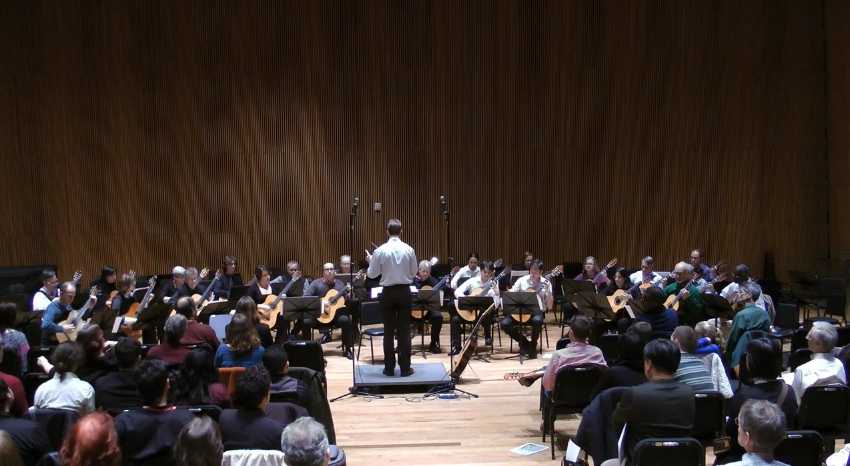Mist, de-"mist"-ified: Enjoyably listening to modern music.

In this video I had the pleasure to conduct Takuma Tanikawa‘s Mist at the Guitar Foundation of America‘s Regional Symposium on December 2nd, 2012. In addition to conducting the band, I improvise a cadenza at the end of the piece, something that I am not very accustomed to doing, though I enjoyed the challenge and found it great fun. (I’d also like to note that Marlon Oliveira and Carlos Nunez, who are both students at Sage Music, were in the orchestra and did a great job.) I think that Mist is a beautiful work, full of challenges and rewards, and something I will definitely be keeping in my catalog.
Mist is very well written for the guitar orchestra, and is an excellent work of art. But I did find it troubling that the many members of the orchestra, when they first encountered the piece, were a bit dismissive of the work. Some even jokingly called the piece “Missed” or made mention of being “Mist-ified” during rehearsal because of the many cues and entrances to keep track of, which makes the work somewhat difficult to perform.
I am happy to say that now they have changed their attitude toward the work. Several members of the orchestra are now thanking me for bringing them such a challenging piece, that widened their horizons, challenged their expectations, and gave them a rewarding experience which allowed them to grow greatly as musicians.
So how did so many members of the band who started with a strong dislike for the music come to like it and appreciate it so much? It has long been a problem for modern musicians and audiences to connect. And why I cannot pin down exactly why this is, I have a few thoughts that I will share here.
- Expectations. I think that many people expect music to be a certain way. But when we deal with modern music composers, we are still dealing with a composer, an individual who has a unique way of expressing himself or herself. If we don’t expect everyone we meet to be exactly the same, then why would we expect them to express themselves in a predictable way? Modern music is in part about defying expectations and being individual.
- Easiness. Modern music deals with the world. Unlike romantic era music, which tends to ignore the realities of the world by opting for rosy, idealized portraits, modernists embrace all that is good and bad in life. They are okay with art being grotesque or ugly, just as they are okay with it being beautiful or sublime as life can both be. We don’t assume that everything in life is easy, so let’s not assume that music must always be easy either. Music can be an escape from our lives, just as it can be a challenge that causes us to grow or shrink. I hope that you will choose to grow with modern music, and not shrink from it.
I’d like to try and help your ears along with this modern work a bit more so that you might appreciate this work sooner than the few months of work it took many people in the orchestra to do. I’d like to start with the composer’s own notes about the piece:
Mist is a meditation on contrast, synthesis and transformation. It also explores the relationships between traditional Japanese music and American folk music as well as different compositional approaches developed in the contemporary art music scene in the United States over the past century. In the piece I was interested in exploring the resonant sounds and textures of the guitar orchestra, an ensemble I had a lot of fun writing for.
The composition was commissioned by Jason Sagebiel and the New York City Classical Guitar Society; it is dedicated to Jason, who is a good friend, and the musicians of this wonderful organization.
The word ‘meditation’ is a good place to start. Meditation is about being open and empty, yet aware. That means being without prejudice, without impulse, and without preconceived notions of how something ought to be. As you watch the video below, try to be open and aware of what you hear, and just experience the music. Meditate with this piece. When you hear the birds and crickets in the woods, you experience them without expecting them sound at certain patterns or intervals. Listen to this music in the same way, as you would enjoy a cool breeze without expecting it to blow on demand.
The title is another indication of the work’s conduct. Mist is not rain, it does not saturate you with moisture. Instead of expecting to be saturated fully in lush and luxurious sound, just enjoy the infrequently falling drops. Just as mists are hazy, you get a hazy image of many musical ideas, that seem to pop suddenly, just as you might run into a tree branch as you walk through the woods unable to see so far ahead of your step, and just as quickly disappear as you travel past.
Your imagination will allow you to hear this in many different ways. Just as each composer may have a unique voice, you may each have a unique way of hearing a musical work. I’d love to hear your thoughts about this piece, and I hope that I was able to help you understand and ‘hear’ the piece.
Related


